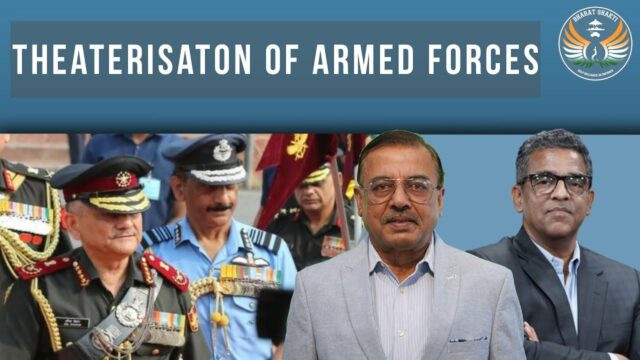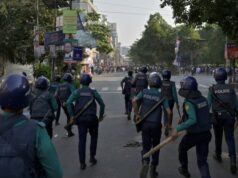In April this year, Nitin Gokhale in a chat on Bharat Shakti on theatre commands, underscored the following points:
“The talk is about having three joint theatre commands with the Western Command, which will handle the western adversary, the Northern Command, which will handle the entire Himalayan border with China, stretching from Ladakh in the West to Arunachal in the east, and also have some of the air assets in the hinterland, like the Central Air Command, and a Maritime Command which has remained constant.”
He also noted that “This is apparently the general consensus that has emerged following talks between the leadership and the three commands and the CDS. This is the ultimate towards which they are now working, although nobody really knows how much of it can really be implemented.”
This is a departure from what the earlier CDS, the late Gen Bipin Rawat had envisaged: Western command for the western adversary, the Northern and Eastern Commands for the China border, and a Maritime command combining the eastern and western Naval commands in Vizag and Mumbai respectively, and an Air Defence Command.
What about the Andaman and Nicobar Islands which is currently the only joint command?
“Andaman & Nicobar one hears contradictory things,” Gokhale said, “one of them being that it could be subsumed in the Northern Command, although I don’t know what the logic behind that is, because logically it should be with the Maritime Theatre command. The Strategic Forces Command will remain outside the ambit of all this, because that has a nuclear command authority, which is controlled by the prime minister through the national security adviser and then there is this whole chain, so that’s a separate issue altogether.”
Given that the current service chiefs would naturally resent losing their autonomy, particularly the Air Force, which doesn’t seem to be represented in the proposed new theatre commands, what kind of pushback was there?
“The Air Force has constantly argued that we do not have enough assets to distribute to every command. And that’s a reality that everyone must face. So what they are saying is that let the control of air assets remain with Air Headquarters, and whenever required, we will support each command,” said Gokhale. “We are not a large country and we do not have expeditionary ambitions like the Americans and others, so therefore they can be switched from one theatre to another as required.”
“For instance,” he continued, “if two squadrons of attack helicopters are allocated to the proposed Western command looking after the Pakistan border, and if things get hot in the Northern command, will the two squadrons allocated to the Western command be twiddling their thumbs? That’s the kind of question that the Air Force has raised. But beyond that, in the past six months, I haven’t heard of any other differences between the three forces, and they seem to be coming around to the view that we have to take it forward, that it is a political direction, so therefore a minimal understanding has to be arrived at before whatever the new structure is finally formalised.”
There is a clear and present threat perception along our northern and western borders, how will such a major transition take place without disrupting operational readiness during that period?
“The leadership is aware of this challenge, and there seems to be a plan which basically calls for putting structures in place for the new theatre commands,” responded Gokhale. “There should be a core team which can be formed from all the three services, led by a new post being created, or perhaps the Chief of the Integrated Defence Staff being named the Vice Chief of Defence Staff, who would be responsible for putting in the place the nuts and bolts of the theatre commands, so that the operation readiness doesn’t get impacted, with the single service commands continuing to function as they are, while the work on the theatre command goes on in parallel, is one thought that I have heard,” he said.
The current CDS sees this as a three-step process,” he continued. “One is creating an enabling environment where the discussions continue in a cordial manner without any anger or rancour, which is an ephemeral continuous process, which is perhaps why we haven’t heard any statements from the services trashing each other so far. The second thing he has done is to go around category A training establishments, talking to officers of the three services personally, as well as asking the three service chiefs to convey the message internally to the officer corps about how this whole thing is being done, and the current status. The third is to understand how to initiate joint warfighting training and planning, and finally logistics as well as procurements.”
According to Gokhale, the current military leadership including the CDC, is not looking for the low hanging fruit, they want to go for the toughest part of actually creating the theatre commands, and then go down to the easier parts like putting in place logistics nodes and training facilities.
So what kind of timelines is the government and the services looking at?
While several small things –like cross postings, having contingents in the army day parade from the navy and air force and vice versa, etc — have been initiated, the political leadership has been clearly told that the timelines suggested to General Rawat in the beginning, were impractical, and sought more time. Which is between 15 and 20 months from now, which would mean the end of 2024 or early 2025, which would be about five years from the time the first CDS was appointed, said Gokhale. He felt it was reasonable given the experience of other major armies of the world, like the Chinese, which took nearly seven to eight years to make this transition..
“The politicians have accepted this, and said that this must be done effectively, with a purpose. Combat effectiveness has to be enhanced, and only then should we look at savings, avoiding duplication, and optimisation of resources, both personnel and equipment,” he concluded.
Related links:
https://bharatshakti.in/indian-military-brass-working-methodically-to-create-theatre-commands/
https://bharatshakti.in/new-cds-general-anil-chauhan-asks-3-defence-forces-to-work-on-creation-of-theatre-commands/
https://bharatshakti.in/disagreements-on-theatre-commands-india-needs-this-project-dont-dump-it-as-unnecessary/
In a career spanning three decades and counting, Ramananda (Ram to his friends) has been the foreign editor of The Telegraph, Outlook Magazine and the New Indian Express. He helped set up rediff.com’s editorial operations in San Jose and New York, helmed sify.com, and was the founder editor of India.com.
His work has featured in national and international publications like the Al Jazeera Centre for Studies, Global Times and Ashahi Shimbun. But his one constant over all these years, he says, has been the attempt to understand rising India’s place in the world.
He can rustle up a mean salad, his oil-less pepper chicken is to die for, and all it takes is some beer and rhythm and blues to rock his soul.
Talk to him about foreign and strategic affairs, media, South Asia, China, and of course India.





